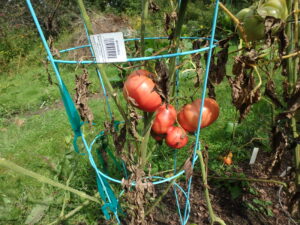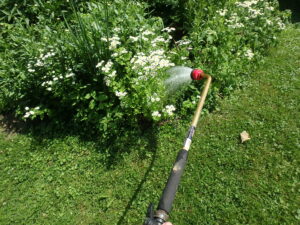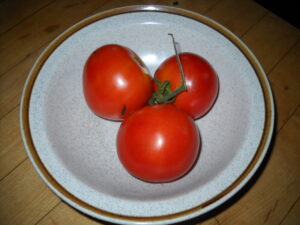Posted on Sunday, June 4, 2023 · Leave a Comment
Heartbreak is rare. More than 10 years ago something called “late blight” came early and infected tomatoes all over New England. Plants blackened and died, and the fruits rotted quickly, becoming inedible. Although many people blamed the Big Box stores, who knows? Spores can travel hundreds of miles in the wind.
Varieties of tomatoes have been bred to resist late blight since that fatal summer. The only one I have grown is called ‘Defiant’, developed by Johnny’s Selected Seeds. It is a nice F-1 hybrid with 4- to 6-ounce fruits that appear early. It is a determinate tomato which means that it produces a crop, then dies. Indeterminate varieties keep on producing until frost or blight kills them.

The leaves here have been killed by a blight which is common but does not affect the fruit
Of lesser portent is ‘early blight’. Except for first time gardeners, we all get it. It causes lower leaves to darken and dry up, but fruit is produced until all the leaves are gone. You can minimize this problem by mulching under your tomatoes with grass clippings or chopped fall leaves. You should do that now. Unlike late blight, early blight survives our winters in the soil, and splash up from hard rains or watering gets it onto the leaves.
Other fungal diseases are common, but can be minimized by spacing your plants well so they are not crowded. I use 24-inches spacing between plants and that seems adequate. It allows good sun sunshine on the leaves and breezes to keep the plants healthier.
To minimize diseases, don’t get the leaves of your tomatoes wet if you can avoid it. Avoid overhead watering devices, even though they are convenient. I use a watering wand to water my veggies as it allows me to direct the water just where my plants need it. It saves water, too, as I am not watering the walkways – and encouraging weeds there. The brand I like best is Dramm. Theirs allow good flow, but are gentle on the plants.

A watering wand directs a soft spray just where you want it
By now most of you have planted your tomatoes. If you haven’t, and if you think this will be a hot, dry summer, plant them deep in the soil. You can bury the root ball six inches down or more, and the stem will grow roots in the cooler, moister soil down deep.
Tomato plants need support. Forty years ago or so, when I was less experienced than I am now, I tried just putting straw on the ground and letting my tomatoes flop over and lay on the ground. I had heard it would work just fine, but it didn’t. It was harder to weed, and tomatoes were more prone to rot.
Now I use tomato cages. They are an investment, but last for 20 years or more, especially if you store them in the barn for winter. Get the biggest ones you can find. Generally that means a wire cage that has four legs (not three), and is 54-inches tall. These cages need to be pushed into the ground at least six inches so they will not tip over. If you have rocky soil, you may have to try several positions before you can install it deep enough.

Remove tomato suckers early and often
Alternatively, you can buy 5- or 6-foot hardwood stakes. These are one inch square stakes that come with a pointed end that you can drive into the soil with a hammer – small rocks or not. But you have to tie your tomatoes to the stakes as they grow up. You can use old rags to tie them on, or sisal twine. Don’t use plastic twine as the vines may get damaged when they are loaded with heavy tomatoes. You may need to tie your tomatoes onto cages, too.
Throughout the summer you should prune out excess “suckers” that grow between the main stalk and a branch. These are just little shoots that develop into branches that clutter up the interior of your plant. They can shade out leaves and encourage diseases. If your plants get too tall in late summer, cut off the tops. This will keep the plants in their cages and putting their energy into producing fruits, not growing taller.

Sun Gold tomatoes
I grow at least a dozen Sun Gold cherry tomato plants each year. Each plant produces more tomatoes than I can count (even if I take off my socks to use both my fingers and toes). They are supremely tasty fresh, and are great dried and saved for soups and stews. I cut each tomato in half, and use a food dehydrator to get it ready for storage. Later, I add them to soups, stews – and even scrambled eggs.
Big tomatoes can be frozen whole and stored in Zipper bags, or chopped and stored in quart jars in the freezer. They aren’t suitable for sandwiches, but they are organic and tasty in cooked dishes.
If you freeze tomatoes whole, all you need to do is make sure they are clean. When you take them out of the freezer, you can remove the skins easily if you want by running them under hot tap water and rubbing gently.
No matter what I do with tomatoes, they always add flavor to any dish. I can’t wait for this season’s crop to be ready.







